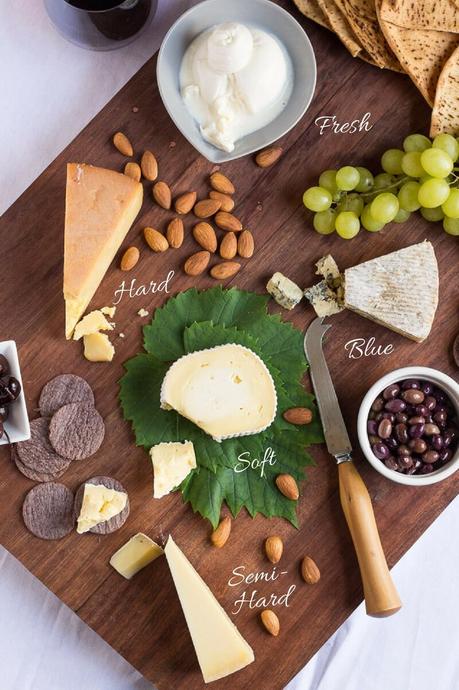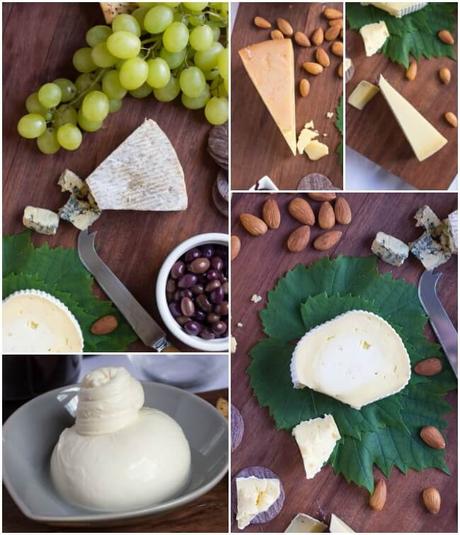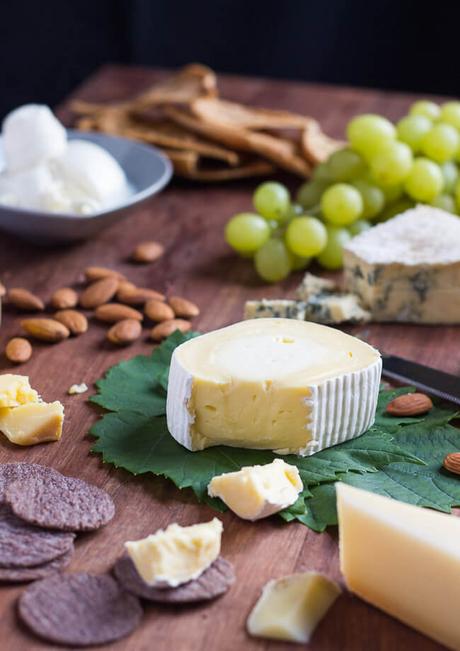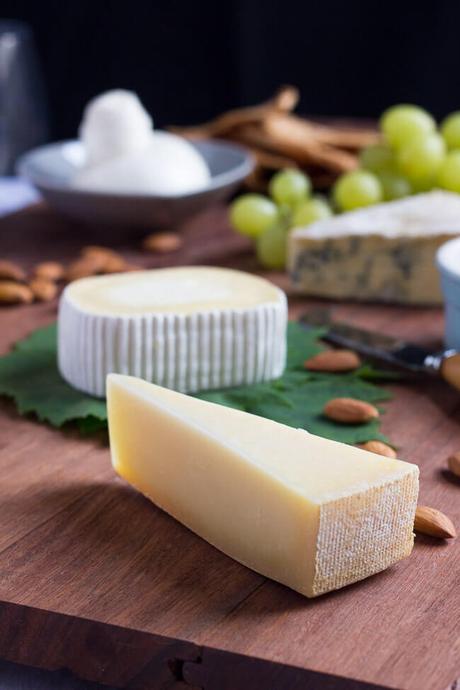This post has been sponsored by Dairy Australia in accordance with my disclosure policy. All opinions remain 100% my own.

January is my favourite time of the year; firmly wedged between Christmas and the start of the school year, I find it the ideal time for lazy catch ups with friends. And every good get together is made all the better with a great cheese platter.
Cheese platters are ideal to serve for casual entertaining. They can be as simple as a single cheese with crackers for a one-on-one with a favourite girlfriend, or you can produce an amazing spread for a large number of guests. A well assembled cheese platter can even double as a meal with the right accompaniments.
What Cheese Should I Use On The Cheese Platter?
With so many fantastic cheeses on offer, it is very easy to get overly excited at the cheese store and come home laden with way more than you need (or is this just me?). A better idea is to approach the cheese section with a plan:
- Work out how many people you are serving. I generally serve one to three cheeses for a quiet get together, with five to seven for a more extravagant spread. The number of cheeses you serve will be dictated by the remainder of the menu, and how fanatical your guests are about cheese. You don't want everyone to fill up before the main event.
- As we eat with our eyes first, use an odd number of cheeses on your platter. Odd numbers are more appealing to the human eye, and are more effective at creating interest.

- There are so many types of cheese available that it helps to divide them into five basic categories to assist with your selection. Whilst a simplistic way to categorise thousands of cheeses, it is an easy way for those of us not familiar with the finer points of cheese making to make a choice for the cheese board. Try to include cheeses from different categories on your cheese platter, rather than a number of cheeses from the same category. Look for:
- Soft Cheese: This category includes white mould and washed rind cheeses, which typically have a soft, creamy centre and are generally everybody's favourite. Try King Island Dairy Black Label Double Brie, Emporium Triple Cream Brie, King Island Dairy Stormy or Flinders Estate Washed Rind.
- Semi-Hard: These cheese have been slightly aged, and are generally very good for melting. They characteristically have sweet nutty or buttery flavours. Try Heidi Farm Raclette, Heidi Farm Tilsit and Section28 Artisan Cheese Monforte.
- Hard Cheese: Usually well aged, with a crumbly texture and well-developed flavour profiles. Look for Westacre Extra Tasty Cheddar, La Vera Matured Pecorino or Ashgove Signature Parmesan.
- Blue Veined Cheese: The most polarising category. People either love or hate blue cheeses. Try King Island Dairy Roaring Forties Blue, King Island Dairy Bass Strait Blue or Berrys Creek Oak Blue
- Fresh Cheese: These are the softest cheeses, and typically have a fresh, milky flavour as they have not undergone aging. Look for Montefiore Trecca or That's Amore Cheese Burrata
- With so many fantastic goats and sheep's milk cheese available, consider developing a platter using cheese made from only one type of milk. Look out for Prom Country Cheese Venus Blue, Meredith Dairy Plain Chevre (a personal favourite of mine - I wax lyrical about it here and here) or Frolicking Goat Buche.
- Keep an eye out for cheeses of different shapes, not just the conventional wedge, or for cheeses rolled in ash, or wrapped in leaves. These add a small point of interest to your platter.
How To Assemble A Cheese Platter.
Now you've got the cheese sorted, it's time to move on to the accompaniments. When it comes to things you can serve with the cheese, you are really only limited by your own imagination. However, with so many options now available, the key is to exercise a bit of restraint so that you don't overwhelm the main focus - the cheese. Offer some good bread or crackers, and then three or four other accompaniments.
If offering the cheese platter as a meal in itself, serve lots of crusty bread on the side. Think slices of thinly sliced baguette, a good sourdough or breads containing walnuts, dried fruits or olives, all of which pair beautifully with cheese.
If serving the cheese platter with pre-meal drinks, I tend to offer a variety of crackers. Plain crackers allow the flavour of the cheese to shine through, whilst strongly flavoured crackers can overwhelm more delicate cheeses so I would leave these off my platter.

Once you have selected your bread or crackers, move on to the other accompaniments. These can be added directly to the cheese board itself if the board is large enough, or served in small bowls to the side. Choose from:
- Fresh seasonal fruits: Try thinly sliced apple or pear in autumn/winter, or use fresh grapes, figs, cherries or strawberries in summer.
- Dried fruits: Apricots and figs are great with cheese. Also try dried muscatels, or even thin slices of panforte.
- Nuts: Almonds and walnuts are traditionally paired with cheese, but don't let this stop you adding your favorite nuts to the cheeseboard. I have yet to find a nut that doesn't play well with cheese. Try using smoked or candied nuts for a little something different.
- Olives: My preference is for lightly marinated Kalamata's, or the little Australian wild olives that are becoming more available. Don't forget to provide a small bowl for the pips.
- Sweet or Savoury Pickles: Try cornichons, pickled walnuts, pickled figs or cherries, or quick pickled onions.
- Cured Meats: Thinly sliced prosciutto or jamon, and salamis make ideal additions to a cheese board.
- Relish: Slightly sweet, but still savoury relishes, work well on a cheese board. Use a good beetroot relish, or try caramelised onions with Brie, Camembert and other soft cheeses.
- Fruit Paste: Thin slices of quince or fig paste are delicious with cheese.

Key Serving Tips For The Best Cheese Platter
Whilst the presentation of your cheese board is key, don't be tempted to crowd the cheeses and accompaniments onto one small board as this can make it difficult to cut the cheese. Spread the cheeses out on a large board, and fill the gaps with fruits and nuts. Consider serving breads and crackers, and other accompaniments, in separate bowls on the side to free up some space on the platter.
Offer a separate knife for each cheese. Not everybody likes a hint of blue on their cheddar.
Cheese platters can be served either with pre-dinner drinks, or after the meal. If you are serving cheese after the meal, consider using sweeter accompaniments such as dried fruits, fruit pastes, fruit and nut breads or panforte, and even a good fruit conserve jam or honey to serve with the cheese.
And most importantly, remove the cheese from the fridge at least one hour before serving. Cold temperatures affect the texture of cheeses, particularly soft cheeses, and mute the flavours. If you are worried about the cheeses drying out, cover the whole board with a damp cloth. Do not skip this step ... your guests will thank you for it.
Want to Win A Years Supply of Cheese?

Now in its 18th year, the Australian Grand Dairy Awards is the grand final of dairy competitions in Australia, recognising and rewarding excellence and quality in Australian dairy produce. 470 of Australia's top dairy products - from milk, cream and butter to yoghurt, ice cream and loads of cheese - were put through a rigorous judging process, assessed by 24 expert judges on flavour, aroma, texture, body and appearance. The judges managed to narrow down the cheese field to just 30 outstanding finalists. I have mentioned some of the finalists above, and you can see a full list of the finalists here.
This year, for the first time, the public have the chance to play judge to determine the champion cheese of the new People's Choice Award. Cheese lovers across the country can cast their vote for their favourite product, and two lucky voters will win a year's supply of Award winning cheese delivered direct to their door. The competition {open only to Australian residents} closes on 13th January 2017, so what are you waiting for ... enter here or go to The Dairy Kitchen Facebook Page for more information.
